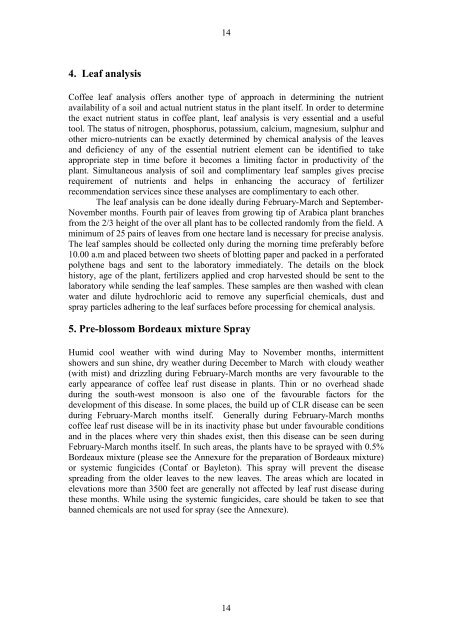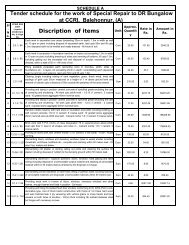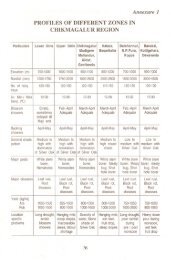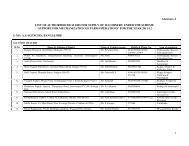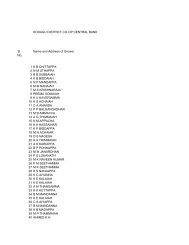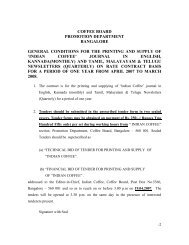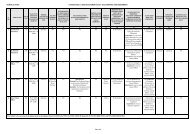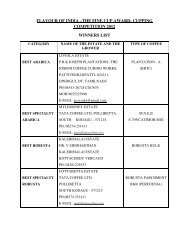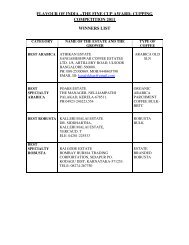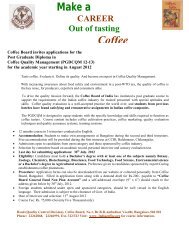COFFEE CULTIVATION GUIDE - Coffee Board of India
COFFEE CULTIVATION GUIDE - Coffee Board of India
COFFEE CULTIVATION GUIDE - Coffee Board of India
Create successful ePaper yourself
Turn your PDF publications into a flip-book with our unique Google optimized e-Paper software.
4. Leaf analysis<br />
14<br />
<strong>C<strong>of</strong>fee</strong> leaf analysis <strong>of</strong>fers another type <strong>of</strong> approach in determining the nutrient<br />
availability <strong>of</strong> a soil and actual nutrient status in the plant itself. In order to determine<br />
the exact nutrient status in c<strong>of</strong>fee plant, leaf analysis is very essential and a useful<br />
tool. The status <strong>of</strong> nitrogen, phosphorus, potassium, calcium, magnesium, sulphur and<br />
other micro-nutrients can be exactly determined by chemical analysis <strong>of</strong> the leaves<br />
and deficiency <strong>of</strong> any <strong>of</strong> the essential nutrient element can be identified to take<br />
appropriate step in time before it becomes a limiting factor in productivity <strong>of</strong> the<br />
plant. Simultaneous analysis <strong>of</strong> soil and complimentary leaf samples gives precise<br />
requirement <strong>of</strong> nutrients and helps in enhancing the accuracy <strong>of</strong> fertilizer<br />
recommendation services since these analyses are complimentary to each other.<br />
The leaf analysis can be done ideally during February-March and September-<br />
November months. Fourth pair <strong>of</strong> leaves from growing tip <strong>of</strong> Arabica plant branches<br />
from the 2/3 height <strong>of</strong> the over all plant has to be collected randomly from the field. A<br />
minimum <strong>of</strong> 25 pairs <strong>of</strong> leaves from one hectare land is necessary for precise analysis.<br />
The leaf samples should be collected only during the morning time preferably before<br />
10.00 a.m and placed between two sheets <strong>of</strong> blotting paper and packed in a perforated<br />
polythene bags and sent to the laboratory immediately. The details on the block<br />
history, age <strong>of</strong> the plant, fertilizers applied and crop harvested should be sent to the<br />
laboratory while sending the leaf samples. These samples are then washed with clean<br />
water and dilute hydrochloric acid to remove any superficial chemicals, dust and<br />
spray particles adhering to the leaf surfaces before processing for chemical analysis.<br />
5. Pre-blossom Bordeaux mixture Spray<br />
Humid cool weather with wind during May to November months, intermittent<br />
showers and sun shine, dry weather during December to March with cloudy weather<br />
(with mist) and drizzling during February-March months are very favourable to the<br />
early appearance <strong>of</strong> c<strong>of</strong>fee leaf rust disease in plants. Thin or no overhead shade<br />
during the south-west monsoon is also one <strong>of</strong> the favourable factors for the<br />
development <strong>of</strong> this disease. In some places, the build up <strong>of</strong> CLR disease can be seen<br />
during February-March months itself. Generally during February-March months<br />
c<strong>of</strong>fee leaf rust disease will be in its inactivity phase but under favourable conditions<br />
and in the places where very thin shades exist, then this disease can be seen during<br />
February-March months itself. In such areas, the plants have to be sprayed with 0.5%<br />
Bordeaux mixture (please see the Annexure for the preparation <strong>of</strong> Bordeaux mixture)<br />
or systemic fungicides (Contaf or Bayleton). This spray will prevent the disease<br />
spreading from the older leaves to the new leaves. The areas which are located in<br />
elevations more than 3500 feet are generally not affected by leaf rust disease during<br />
these months. While using the systemic fungicides, care should be taken to see that<br />
banned chemicals are not used for spray (see the Annexure).<br />
14


